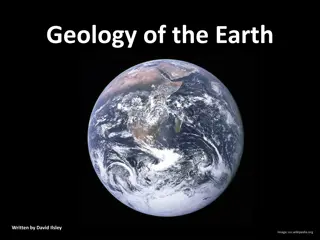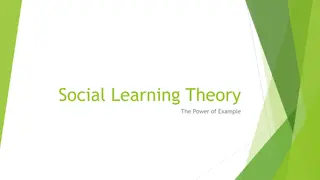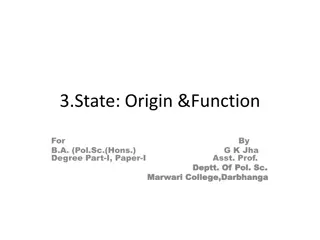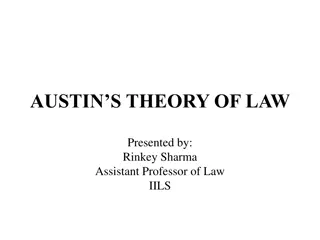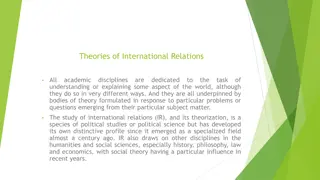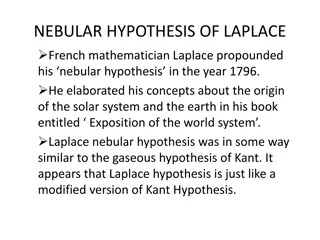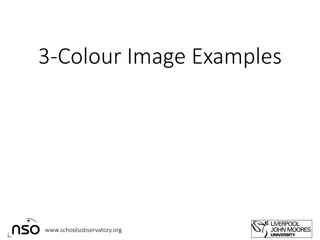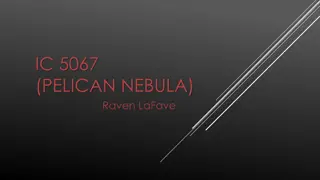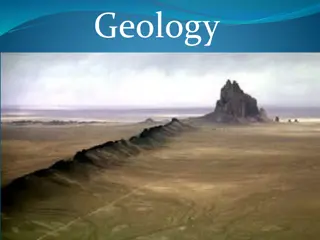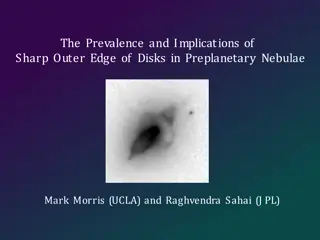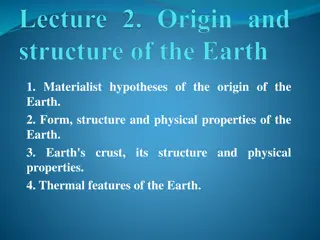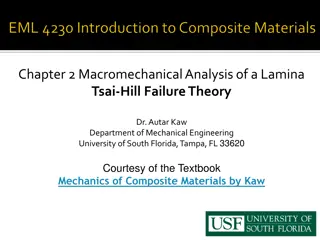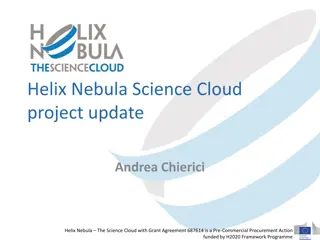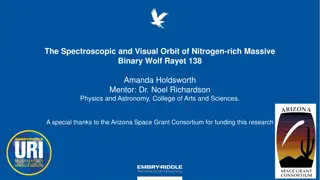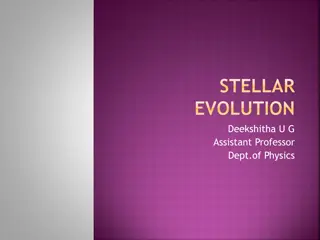Ginzburg Landau phenomenological Theory
The Ginzburg-Landau phenomenological theory explains superconductivity and superfluidity as distinct thermodynamic phases. It focuses on phase transitions characterized by singularities in specific heat at the transition temperature. Derived from BCS theory, it quantifies condensation energy, emphas
1 views • 38 slides
Understanding Nebulae: From Kant's Proposal to Hubble's Discoveries
In 1755, Kant proposed that nebulae are island universes, sparking a debate on their nature within or outside our galaxy. Shapley and Curtis debated whether spiral nebulae were rotating systems like our Milky Way. Hubble's observations of the Andromeda Nebula led to the realization that it is a gala
10 views • 166 slides
Crystal Field Theory in Transition Metal Complexes
Crystal Field Theory (CFT) explains the colors and magnetic properties of transition metal complexes. It focuses on the energy changes in d-orbitals of metal ions caused by surrounding ligands. This theory, developed in 1929, provides insights into the bonding interactions in complex compounds. The
10 views • 44 slides
The History of the Earth
The Earth, 4.5 billion years old, emerged from a nebula in the Milky Way Galaxy. Gravity led to the condensation of a rotating cloud into the Sun and planets. Over time, lumps collided, forming gas giants, rocky planets, and asteroids. The outer planets attracted hydrogen and helium, while the inner
2 views • 45 slides
Geology of the Earth
The evolution of elements in the universe began with the Big Bang, leading to the formation of hydrogen, helium, and heavier elements through stellar processes like fusion and supernovae. Our solar system formed 4.5 billion years ago from a nebula containing a variety of elements. These elements pla
4 views • 44 slides
Understanding Social Learning Theory and the Power of Example
Social Learning Theory, introduced by Bandura, emphasizes learning through observation and modeling. It explores how individuals acquire behavioral dispositions, trial-and-error experiences, and the impact of stimuli in the environment. The theory focuses on the importance of attention, retention, a
1 views • 17 slides
Evolution of Mathematical Theories and Proof Systems
Development of mathematical theories such as model theory, proof theory, set theory, recursion theory, and computational complexity is discussed, starting from historical perspectives with Dedekind and Peano to Godel's theorems, recursion theory's golden age in the 1930s, and advancements in proof t
1 views • 29 slides
Introduction to Organizational Behavior: Management Theories and Practices
Explore the evolution of organizational behavior from early management theories to contemporary practices. Understand the historical foundations and relevance of management theory in shaping workplace dynamics. Delve into key concepts like Scientific Management, Administrative Management, Bureaucrat
1 views • 28 slides
Theories on the Origin of State: Divine, Force, Patriarchal, and More
Various theories such as Divine Origin, Force Theory, Patriarchal Theory, and others explain the origin of the state. Divine theories attribute state creation to God, while Force Theory emphasizes the strong subjugating the weak to establish authority. Each theory offers unique perspectives on the h
1 views • 24 slides
Understanding Forgetting: Theories and Influence on Memory Recall
Forgetting is a complex phenomenon influenced by theories such as Decay Theory, Interference Theory, and Motivated Forgetting. The Ebbinghaus forgetting curve highlights how memories fade over time. Decay Theory suggests memories decay over time, while Interference Theory explains how old and new me
0 views • 25 slides
Psychological Theories of Criminality: Understanding the Roots
Psychological theories of criminality delve into the association between intelligence, personality, learning, and criminal behavior. Major theories include Psychodynamic Theory by Freud, Behavioral Theory by Bandura, and Cognitive Theory by Kohlberg. These theories explore how unconscious mental pro
1 views • 20 slides
Austin's Theory of Law by Rinkey Sharma: An Overview
Austin's Theory of Law, presented by Rinkey Sharma, delves into the Imperative Theory of Law as proposed by Austin, known as the father of English jurisprudence. It explores General and Particular Jurisprudence, Austin's definition of law, and the elements of positive law, emphasizing the concepts o
0 views • 11 slides
Theories of International Relations Overview
The field of International Relations (IR) encompasses various theories that seek to explain global phenomena, drawing from disciplines like history, philosophy, and economics. Theory, derived from contemplation and speculation, organizes ideas to explain issues such as state emergence, conflict caus
1 views • 47 slides
Understanding the Gate Control Theory of Pain in Pain Management
This detailed content delves into the Gate Control Theory of Pain, explaining pain pathways involving nociceptors, A-delta fibers, and C fibers. It further explores central pain pathways like the spinothalamic tract, spinomesencephalic tract, and spinoreticular tract. The theory's mechanism of pain
3 views • 11 slides
Understanding the Theory of Firms: Neoclassical vs. Modern Approaches
The theory of firms is explored through the Neoclassical and Modern perspectives. Neoclassical theory focuses on profit maximization, while Modern theory delves into managerial, principal-agent, and transaction cost theories. The discussion covers criticisms of Neoclassical theory and the essential
1 views • 79 slides
Laplace's Nebular Hypothesis: Origin of the Solar System
French mathematician Laplace proposed the nebular hypothesis in 1796, refining Kant's gaseous hypothesis. Laplace asserted a hot rotating gaseous nebula cooled gradually, contracting and increasing rotation speed. Eventually, centrifugal forces led to the formation of ring structures, contrasting wi
0 views • 6 slides
Theories of Causation in Psychological and Social Sciences
Overview of theories of causation categorized into psychological, social psychological, and sociological perspectives. Psychological theories focus on instinctive, biological, and psychological qualities of abusers, including Attachment Theory, Psychodynamic Theory, Social Learning Theory, and Situa
0 views • 15 slides
Understanding Political Theory through a Contextual Approach
Exploring G.H. Sabine's perspective on political theory through a contextual approach, emphasizing the importance of historical context and societal influences. Sabine argues that while political theory evolves with its contemporary politics, it should be analyzed within its specific time and social
0 views • 9 slides
Evolution of Light Theory: From Wave Theory to Quantum Theory
At the turn of the century, the discovery of the photoelectric effect challenged the wave theory of light, leading to the development of the quantum theory by Max Planck and Albert Einstein. This new theory introduced the concept of discrete energy units known as quanta, bridging the gap between wav
1 views • 62 slides
Stunning Images of Nebulas and Galaxies from Schools Observatory
Explore mesmerizing images of Triangulum Galaxy, Bubble Nebula, Crab Nebula, Eskimo Nebula, Dumbbell Nebula, and Eagle Nebula captured by Schools Observatory. Each image showcases the beauty and intricacy of space, inviting viewers to marvel at the wonders of our universe. Immerse yourself in the co
0 views • 7 slides
Dp-branes, NS5-branes, U-duality, and M-Theory Overview
Overview of Dp-branes, NS5-branes, and U-duality derived from nonabelian (2,0) theory with Lie 3-algebra. Introduction to M-theory, including M2-branes and M5-branes in the strong coupling limit. Discussion on BLG theory, Lorentzian Lie 3-algebra, and the ABJM theory for M2-branes.
1 views • 32 slides
Exploring IC 5067: The Pelican Nebula and Herbig-Haro Objects
Delve into the beauty and mysteries of IC 5067, the Pelican Nebula, located in the Cygnus constellation. Discover its unique features, including emission nebula jets emitted by Herbig-Haro object 555. Follow the imaging process using a Meade LX200 telescope and ST-9XE camera. Uncover the challenges
0 views • 11 slides
Understanding Time-Independent Perturbation Theory in Quantum Mechanics
Perturbation theory is a powerful tool in solving complex physical and mathematical problems approximately by adjusting solutions from a related problem with known solutions. This theory allows for more accurate approximate solutions by treating the difference as a small perturbation. An example inv
0 views • 19 slides
Ethical Theories: Divine Command vs. Virtue Theory Explained
Divine Command Theory asserts that morality is derived from God's commands, contrasting with Virtue Theory which focuses on developing moral virtues to achieve human flourishing and excellence. Divine Command Theory relies on religious texts, while Virtue Theory emphasizes the cultivation of virtues
0 views • 24 slides
Understanding Fermi Liquid Theory in Interacting Fermion Systems
Fermi liquid theory, also known as Landau-Fermi liquid theory, is a theoretical model that describes the normal state of metals at low temperatures. Introduced by Landau and further developed by Abrikosov and Khalatnikov, this theory explains the similarities and differences between interacting ferm
0 views • 23 slides
Exploring the Fascinating World of Geology and Earth Sciences
Delve into the diverse field of geology, covering topics such as physical and historical geology, geochronology, mineralogy, petrology, and more. Learn about the solar nebula hypothesis and the Earth's lithosphere, hydrosphere, atmosphere, and biosphere. Discover the composition of Earth's atmospher
0 views • 12 slides
The Prevalence and Implications of Sharp Outer Edge of Disks in Preplanetary Nebulae
Recognizable preplanetary nebulae typically exhibit bipolar structures with an opaque disk that contains a density discontinuity at a certain radius. These disks, when appropriately tilted, can block light from the rear lobe of the nebula, leading to the observation of a sharp outer boundary. Studie
0 views • 17 slides
Computational Learning Theory: An Overview
Computational Learning Theory explores inductive learning algorithms that generate hypotheses from training sets, emphasizing the uncertainty of generalization. The theory introduces probabilities to measure correctness and certainty, addressing challenges in learning hidden concepts. Through exampl
0 views • 43 slides
Automata Theory and Theory of Computation Overview
This course overview covers concepts in automata theory and theory of computation, including formal language classes, grammars, recognizers, theorems in automata theory, decidability, and intractability of computational problems. The Chomsky hierarchy, interplay between computing components, modern-
0 views • 42 slides
Journey Through Earth's Formation and Evolution
Explore the origins of the Earth through the Big Bang Theory, Nebula Theory, Iron Catastrophe, and Formation of the Moon. Learn about Earth's layers, Pangea supercontinent, and the fascinating processes that shaped our planet over billions of years.
0 views • 7 slides
Theories of Interest in Microeconomics II
Explore various theories of interest in economics, including the Classical Theory, Liquidity Preference Theory by Keynes, Productivity Theory, Abstinence Theory, Time-Preference Theory, Fisher's Time Preference Theory, and the Loanable Fund Theory. These theories offer different perspectives on the
0 views • 6 slides
Exploring the Evolution of Atomic Theory
Delve into the historical journey of atomic theory starting from Democritus and Aristotle's views to modern advancements proving some aspects of Dalton's theory incorrect. Learn about key laws and theories such as the Particle Theory of Matter, Dalton's Atomic Theory, and JJ Thomson's discoveries, s
0 views • 30 slides
Hypotheses on the Origin of Earth and Earth's Formation
Various materialist hypotheses proposed by scientists such as Kant, Laplace, Schmidt, and Fesenkov regarding the origin of Earth and the solar system. These hypotheses suggest different processes, including the formation from primary dusty matter, hot nebula, interstellar meteorite dust, and gas-dus
0 views • 16 slides
The Complicated Formation of Earth's Water: A Detailed Overview
Jun Wu and colleagues at Arizona State University have developed a comprehensive model to explain the origin of Earth's water through stages such as planetary accretion, core formation, and interactions with the solar nebula. By tracing the isotopic composition of hydrogen, they explore how water so
0 views • 7 slides
Unveiling Dark Nebulae and Stellar Formation in Space
Dark Nebulae like the Coalsack Nebula and Snake Nebula are dense interstellar clouds where light cannot pass through. Comprised of tiny dust particles coated in frozen gases, they serve as precursors to stellar nurseries, where protostars begin to form and evolve. Learn about these enigmatic cosmic
0 views • 11 slides
Macromechanical Analysis of Lamina and Tsai-Hill Failure Theory Overview
The Tsai-Hill failure theory is based on the strengths of a unidirectional lamina, incorporating longitudinal and transverse tensile and compressive strengths, as well as in-plane shear strength. This theory, derived from the distortion energy theory, provides criteria for determining lamina failure
0 views • 15 slides
Incredible Images Captured by the Hubble Space Telescope
The Hubble Space Telescope, launched in 1990, is the first of the four Great Observatories. It has captured breathtaking images of celestial wonders including the Cat's Eye Nebula and two galaxies colliding. The telescope's remarkable capabilities are showcased in these mesmerizing visuals, demonstr
0 views • 10 slides
Helix Nebula Science Cloud Project Overview
Helix Nebula Science Cloud project, funded by H2020, involves a Joint Pre-Commercial Procurement by various procurers like CERN and CNRS. The project phases include preparation, analysis, and pilot platform development. Contractors like RHEA and T-SYSTEMS are involved in providing cloud solutions. I
0 views • 10 slides
Studying Wolf-Rayet Stars: The Spectroscopic and Visual Orbit of WR 138
Wolf-Rayet (WR) stars are evolved, massive stars with their outer hydrogen envelopes stripped away, leading to strong stellar winds. Understanding these nitrogen-rich, carbon-rich, and oxygen-rich WR stars is crucial in unraveling their formation and contribution to nebula creation. This research de
0 views • 10 slides
Journey of a Star: Stellar Evolution Explained
Explore the stages of stellar evolution, from the birth of a protostar in a nebula to the dramatic transformations leading to the formation of red giants, white dwarfs, and black dwarfs. Understand phenomena like gravitational collapse, temperature changes, radiative processes, and the Chandrasekhar
0 views • 7 slides




